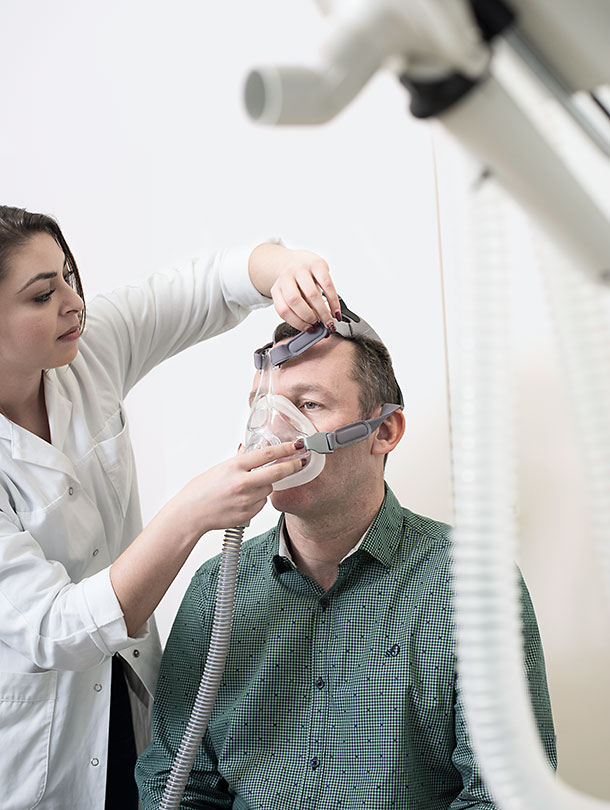Nightly respiratory arrest
Text: Christoph Dieffenbacher
Heavy snoring accompanied by interruptions in breathing can lead to serious health problems. In Basel, pulmonologists are investigating the mechanisms that put constant stress on snorers suffering from sleep apnea. Possible therapeutic approaches are also being identified.
Not all forms of snoring are alike. In its harmless form, it is merely a nuisance for the sleeper’s partner. However, a dangerous form of snoring, known as sleep apnea, is characterized by violent snorts and gasps. Basel pulmonologist Professor Michael Tamm explains the problem: Since the muscle tone in the throat is reduced during sleep, especially if the sleeper is lying on their back, the airways tend to narrow. As a result, breathing becomes shallower and may even be interrupted. In that case, blood oxygen saturation decreases after a few seconds, which in turn prompts the brain to issue an urgent command to breathe again. Respiration restarts abruptly, causing the blood oxygen level to rise – until the sleeper’s throat muscles relax again and the process begins anew.
This continual up and down, explains Tamm, puts the snorer’s organism under permanent nocturnal stress, of which they are unaware. However, when their brain activity is measured, the electroencephalogram (EEG) reveals that they repeatedly come close to waking. In other words, they have a bad night’s sleep. Understandably, they feel sleepy and exhausted throughout the following day, have difficulty concentrating, and may even lapse into microsleep. If their condition goes untreated, sleep apnea sufferers will be unfit for certain types of work such as truck driving or chauffeuring.
“Affects up to a third of the population”
The medical researchers have defined a threshold for what constitutes severe sleep apnea: Anything up to five “snorting episodes” per hour is deemed normal, while an average of 15 or more is clearly harmful. Professor Tamm points out that this condition, which is known as “obstructive sleep apnea syndrome”, entails a “significantly increased risk of suffering a heart attack or stroke”. The risk is greatest in men over 40. Other risk factors include being overweight, having high blood pressure, drinking, and smoking. Sleep apnea can, however, affect anyone. “Up to a third of the Swiss population suffers from some form of the condition,” he says, adding, “and it has recently been found that sleep apnea also occurs in children.”
Modern treatment approaches focus on preventing excessive relaxation of the throat muscles. CPAP (continuous positive airway pressure) masks are worn during the night and work “like a vacuum cleaner in reverse,” blowing air into the nose and thus widening the throat so that there is enough room to breathe, as Tamm explains. And it seems that these masks, which the sleep lab adjusts for each patient, are effective: “After a few days, many patients report feeling better and more awake.” The University Hospital Basel alone provides CPAP masks to about 200 patients every year. As an expert in the field, Professor Tamm does not think much of aids such as nasal strips, mouthguards, and palatal expanders – or the idea of sewing a tennis ball into the back of a snorer’s pajamas.
Investigating biomarkers
In a longitudinal study involving almost 300 people with suspected sleep apnea, Tamm and his team looked at specific biomarkers – potential indicators of the condition – that can identify oxygen deprivation caused by sleep apnea. The scientists discovered that one of the markers, the hormone vasopressin, is a possible indicator of untreated sleep apnea. The team also conducted another study, which found that an organic compound called adrenomedullin could potentially be used as a marker to monitor therapeutic success. Adrenomedullin, a peptide that dilates blood vessels, was examined in lung cell cultures that were given a reduced supply of oxygen.
A patient’s decision to lose as much weight as possible is unlikely to help combat sleep apnea. After all, if you feel tired and drained all day, the temptation to eat snacks now and again is all the greater…

